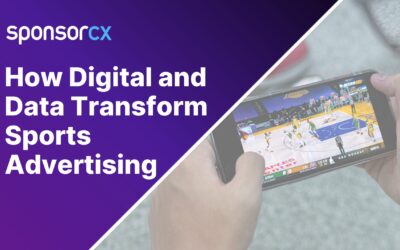How to Calculate Sponsorship ROI
An old advertising adage goes something like this: “I know I’m wasting half of my advertising dollars. I just don’t know which half.” It mirrors the challenge of calculating sponsorship ROI. Both highlight the difficulty in pinpointing which investments drive results and which do not. Just as advertisers struggle to identify waste, marketers often struggle to attribute specific returns to sponsorships. That’s why it’s crucial to use data-driven metrics and analytics to reveal where value is generated — and where it’s not.
Sponsors expect a clear and measurable ROI for their investments. They look for increased brand visibility, audience engagement, and direct sales or lead generation. They expect their financial involvement to translate into meaningful business outcomes. They want proof that their investments contribute to their overall marketing and financial goals. They want to see tangible benefits like enhanced brand perception, access to new markets, or a boost in social media presence, to name a few.
What Is the Return on Investment for Sponsorships?
What’s the desired ROI? Many sponsors report wanting at least a two-to-one ROI for an activation. The math is straightforward. Divide the amount of the expected dollar benefit by the sponsorship’s dollar value. For example, if the anticipated dollar benefit from the sponsorship is $15,000 and the cost of the sponsorship is $3000, the ROI is 5 (15,000/3,000=5). That would be considered an excellent ROI.
Let’s discover how we can calculate sponsorship ROI to accurately understand how metrics can translate into realized income.
ROI for Athletic Teams and Individuals
Calculating sponsorship ROI for athletic teams and individuals is measured by analyzing specific metrics that reveal the value of the partnership. There are unique factors that apply to athletic teams and individuals. Fan engagement, media exposure, and brand alignment are crucial when evaluating event ROI metrics.
Key considerations include measuring audience reach through social media impressions, broadcast views, and in-person attendance. Sponsorship metrics like merchandise sales, website traffic, and new follower growth also provide insights into sponsorship effectiveness. For teams, the value extends beyond a single event. Ongoing community involvement and sustained brand interactions are crucial metrics.
How is sponsorship success measured for individual athletes? Performance on the field, media appearances, and personal brand growth play significant roles. Sponsors often seek authentic engagement in which the athlete’s actions resonate with fans and reinforce the brand’s message.
Both teams and athletes must provide sponsors with detailed post-event reports outlining these metrics. By aligning sponsorship goals with measurable outcomes, athletic teams and individuals can demonstrate the true value of their partnerships.
ROI for Venues
Venues host various events, including sports, conventions, seminars, and concerts. When calculating ROI, they will consider factors like audience demographics, foot traffic, and brand exposure.
So, how are sponsorship success and ROI measured at venues? One key factor is visibility. Banners, digital displays, and naming rights all contribute to brand awareness. Sponsorship metrics such as attendee engagement, on-site activations, and social media interactions provide valuable data points. Measuring the number of people who engage with branded areas or participate in sponsor-driven activities helps quantify the impact.
Event ROI metrics include ticket sales influenced by the sponsorship, increased concessions revenue, and enhanced attendee satisfaction. Surveys can provide feedback on brand recall and perception, showing how the sponsorship resonates with the audience.
Venues must also provide sponsors with reports clearly outlining these metrics and demonstrating how partnerships drive business value. By focusing on these specific considerations, venues can better showcase the tangible benefits of sponsorship and help sponsors recognize their investment as a strategic tool for reaching their target audience.
ROI for Events
Calculating sponsorship ROI for events involves evaluating how well the sponsorship aligns with event goals and audience engagement. Metrics like brand visibility, attendee interaction, and social media buzz are all part of the mix. Tracking impressions through branded signage, digital ads, and event mentions provides insight into brand reach. Event ROI metrics also include lead generation, where sponsors collect valuable data from attendees through activations, contests, or digital touchpoints.
Audience feedback is another important aspect of ROI calculation. Post-event surveys can capture attendees’ brand recall and sentiment, showing how the sponsorship resonated. Additionally, analyzing sales data, both on-site and online, can highlight the direct influence of the event on consumer behavior.
Again, transparent reporting is required. Reporting can highlight successes, such as increased brand awareness, audience engagement, and sales lift. This kind of information validates sponsor investments. Event organizers who can clearly demonstrate ROI can create stronger sponsor relationships and make future collaborations more attractive.
How to Make Your ROI Calculations
Calculating sponsorship ROI is the basis for understanding the real impact of sponsor investments. Knowing what and how to measure helps to identify what works and what doesn’t. By looking closely at sponsorship metrics and event ROI metrics, we can determine how to measure sponsorship success and make data-driven decisions for future partnerships. There are five indispensable areas of focus. These are equally important for teams, individuals, venues, or events.
Gather Data
Whatever the nature of your property, if you want to calculate ROI, it’s imperative to gather data. To accurately measure sponsorship effectiveness, you must collect relevant data points that reflect the impact of partnerships. This process involves gathering sponsorship metrics that align with sponsors’ specific goals, such as brand exposure, audience engagement, and revenue generation.
One key metric is measured through tracking digital and physical interactions. Metrics like social media mentions, website traffic, and in-venue activations offer insight into audience behavior. From a sports team perspective, the Los Angeles Lakers track sponsorship effectiveness through advanced analytics that measures everything from branded content engagement on social platforms to app downloads driven by sponsor promotions. These metrics help the Lakers demonstrate value to their sponsors by highlighting how specific activations directly contribute to increased brand visibility and fan engagement.
Event ROI metrics such as ticket sales, merchandise purchases, and on-site sponsor activations provide additional layers of data. Data gathering also involves post-event surveys and sentiment analysis, which help capture audience perceptions of the sponsor.
Without robust data collection, it’s impossible to understand how well a sponsorship performs. Properties prioritizing data gathering can effectively showcase the tangible benefits of sponsorships, ensuring their partners see a clear return on investment. This approach builds stronger relationships with sponsors by providing transparent, evidence-based results.
Define Your Goals
Clear goals are essential when calculating sponsorship ROI. Goals set the framework for measuring sponsorship effectiveness. Without well-defined objectives, against what would sponsorship success be measured? How would we know which sponsorship metrics are most relevant? Goals provide the roadmap. They guide all properties in collecting data and assessing the value of their partnerships.
Madison Square Garden often partners with brands to enhance fan experiences and increase brand visibility. To measure the success of these sponsorships, The Garden sets specific goals such as boosting in-venue engagement, driving sales through branded concessions, and increasing social media mentions tied to sponsor activations.
By establishing specific goals, venues can accurately measure sponsorship effectiveness using event ROI metrics like fan interaction rates, sales data, and media coverage. If the goal is to improve the fan experience, metrics like satisfaction surveys and repeat attendance are key indicators.
Having clear, measurable goals to measure results against enables all properties, whether venues, teams, individuals, or events, to provide sponsors with concrete data demonstrating how the partnership meets their objectives. Transparency builds enduring relationships. Sponsorship investments are seen as strategic, valuable, and results-driven. Defining goals isn’t just about tracking outcomes—it’s about making every sponsorship effort purposeful and aligned with the desired results.
Assign Value to Metrics
To measure sponsorship effectiveness, each metric must be assigned a dollar value that reflects its contribution to overall business goals. Understanding how sponsorship success is measured depends on aligning these values with specific sponsorship metrics and event ROI metrics. This can be tricky because metrics such as social media touches, lead generation, and brand awareness are not valued similarly. A healthy dose of subjectivity is required.
One common approach is to value media exposure, such as brand mentions, at the rate of equivalent paid advertising. If a sponsor receives 10 million impressions from signage at an event, the value is compared to what it would cost to reach the same audience through paid media.
A real-world example is the partnership between the NFL and Pepsi. Pepsi measures the value of its sponsorship by analyzing metrics like brand visibility during televised games, social media mentions, and in-stadium activations. Each sponsorship metric is assigned a value based on potential advertising costs, increased sales, or customer engagement levels that Pepsi has defined.
By assigning value to each metric, Pepsi can determine how much the sponsorship contributes to sales growth and brand awareness. This approach provides a clear picture of ROI and shows exactly how the sponsorship drives financial returns.
Accurate metric valuation enables sponsors to make informed decisions. It transforms abstract data into actionable insights. It allows sponsors to see the impact of their involvement and how every metric supports the bottom line.
Efficient Reporting
Accurate and timely reporting presents critical data clearly and understandably. Efficient reporting provides a shared understanding between sponsors and rights holders regarding sponsorship metrics and the ROI metrics that matter most.
Take a look at Coca-Cola’s sponsorship of the Olympic Games. With detailed reports, Coca-Cola measures metrics like brand exposure, social media engagement, and sales lift during the event. These reports compile data from various sources, including TV broadcasts, digital platforms, and in-venue interactions, allowing Coca-Cola to assess the impact comprehensively.
Coca-Cola can quickly identify which aspects of the sponsorship deliver value and which areas may need adjustment. Clear reporting provides transparency that helps to justify the investment to stakeholders and refine future strategies.
By streamlining the reporting process, sponsors can focus on leveraging insights to enhance future sponsorships. They can maximize the prospect that every dollar will be spent effectively. Efficient reporting is not just about data collection; it’s about turning that data into meaningful insights that drive decisions.
What Types of Metrics Should You Measure?
When calculating sponsorship ROI, focus on specific metrics that reveal the true impact of a sponsorship. Here are the key performance indicators (KPIs) of success.
- Impressions provide a snapshot of how many people saw the brand, whether through signage, media coverage, or digital platforms.
- Clicks on targeted sites track direct engagement with sponsored content, highlighting interest and driving traffic to websites.
- Generated leads and their quality are critical metrics, indicating not just the quantity of leads but also their potential to convert into actual sales, which directly impacts the bottom line. Qualified leads are more valuable.
- Social media interactions, including likes, shares, and comments, help measure how sponsorship success is felt across digital platforms. They show how well sponsorships resonate with the target audiences.
- Customer feedback gathered through surveys or direct interactions provides valuable insights into brand perception and overall experience. These are arguably the best of all measurable metrics.
These sponsorship metrics provide a comprehensive view of how a sponsorship performs against set goals. By measuring these elements, sponsors can make data-driven decisions, refine their strategies, and increase the likelihood that their investments drive the desired outcomes.
Why Spend Time on ROI Calculations?
Spending time on ROI calculations provides a clear understanding of how sponsorship investments contribute to overall success. Calculating sponsorship ROI helps determine how to measure sponsorship effectiveness. It provides alignment with partnerships and business objectives. It validates and proves tangible value. Here are some of the reasons why every business should know how to calculate ROI.
- Knowing how sponsorship success is measured allows businesses to identify which sponsorship metrics matter.
- Spending time on ROI calculation helps justify the investment to stakeholders.
- ROI calculation demonstrates the sponsorship’s financial and strategic value.
- It provides a roadmap for optimizing future sponsorships and enables businesses to refine their approach and focus on partnerships that drive significant returns.
- ROI calculations turn abstract data into actionable insights. Businesses can then make informed decisions about where to allocate their investment spending.
- By thoroughly evaluating the impact of each sponsorship, companies can maximize their investments, enhance brand visibility, and ultimately achieve their marketing and financial goals.
The Bottom Line
There is no substitute for calculating sponsorship ROI. Its value in understanding the benefits or possible disadvantages of activation investments cannot be overstated. Knowing how to measure sponsorship effectiveness and which sponsorship metrics matter will optimize partnerships and demonstrate impact to stakeholders. Businesses can refine their strategies and ensure every dollar spent furthers their goals. To learn more about measuring sponsorship success, contact SponsorCX today for expert guidance on maximizing your sponsorship investments.











